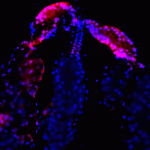Lien vers Pubmed [PMID] – 34899388
Lien DOI – 10.3389/fphys.2021.763195
Front Physiol 2021 ; 12(): 763195
Mosquito-borne flaviviruses, such as dengue (DENV), Zika (ZIKV), yellow fever (YFV), West Nile (WNV), and Japanese encephalitis (JEV) viruses, threaten a large part of the human populations. In absence of therapeutics and effective vaccines against each flaviviruses, targeting viral metabolic requirements in mosquitoes may hold the key to new intervention strategies. Development of metabolomics in the last decade opened a new field of research: mosquito metabolomics. It is now clear that flaviviruses rely on mosquito lipids, especially phospholipids, for their cellular cycle and propagation. Here, we review the biosyntheses of, biochemical properties of and flaviviral interactions with mosquito phospholipids. Phospholipids are structural lipids with a polar headgroup and apolar acyl chains, enabling the formation of lipid bilayer that form plasma- and endomembranes. Phospholipids are mostly synthesized through the de novo pathway and remodeling cycle. Variations in headgroup and acyl chains influence phospholipid physicochemical properties and consequently the membrane behavior. Flaviviruses interact with cellular membranes at every step of their cellular cycle. Recent evidence demonstrates that flaviviruses reconfigure the phospholipidome in mosquitoes by regulating phospholipid syntheses to increase virus multiplication. Identifying the phospholipids involved and understanding how flaviviruses regulate these in mosquitoes is required to design new interventions.

